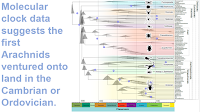Pseudoscorpions are a somewhat overlooked group in Korea, with only 25 species reported from the country, from twelve genera and seven families, which is likely to be a considerable underestimation of the total. The family Syarinidae, which contains 125 species and has a worldwide distribution, is known only from a single species in Korea, Pararoncus japonicus (which is also known from Japan). Pararoncus japonicus is also interesting in that it is widespread and found in leaf litter, whereas all other described species in the genus have very limited distributions, often within caves, with the exception of Pararoncus histrionicus, which was discovered 'taken at quarantine in Hawaii', originating from an unknown point in Japan.
In a paper published in the jounal Evolutionary Systematics on 2 April 2024, Kyung-Hoon Jeong of Seoul National University, the Species Diversity Research Division of the Korean National Institute of Biological Resources, and the Department of Agricultural Convergence Technologty and Laboratory of Insect Phylogenetics & Evolution at Jeonbuk National University, Danilo Harms of the Museum of Nature Hamburg, the Harry Butler Institute at Murdoch University, and the Australian Museum Research Institute, and Jung-Sun Yoo, also of the Species Diversity Research Division of the Korean National Institute of Biological Resources, describe two new species of Pararoncus from South Korea.
The first new species is named Pararoncus leonardi, in honour of basketball player Kawhi Leonard who has the longest wingspan in the American National Basketball Association. The species is described from six specimens, three male and three female, collected from moist leaf litter habitats on Mount Sobaek in the Sobaek Mountains of Chungcheongbuk Province, 741 m above sealevel, in April and May 2022.
Specimens of Pararoncus leonardi are between 3.32 and 3.98 mm in length, and reddish browm in colour with paler abdomens and legs. Unusually for a the genus, all specimens have four well-developed, lensed eyes (most species of Pararoncus only have a two eyes).
The second new species is named Pararoncus taeyoungi, where honours the former Korean Basketball League player Tae Young Moon who has the longest wingspan ratio in the Korean Basketball League. This species is also described on the basis of six specimens, three male and three female, collected from leaf litter on Mount Bangtae in Gangwon Province, 621 m above sealevel, in October 2022.
Specimens of Pararoncus taeyoungi range from 2.77 mm to 3.32 mm in length and reddish brown in colour with the abdomen and legs being lighter, and a dark brown rear margin to each abdomen segment. Like Pararoncus leonardi, Pararoncus taeyoungi has two pairs of well developed, lensed eyes; the two species are generally similar to one another, but Pararoncus taeyoungi is notably smaller, and the proportion of the tarsus to the rest of the leg is larger in Pararoncus leonardi.
See also...











